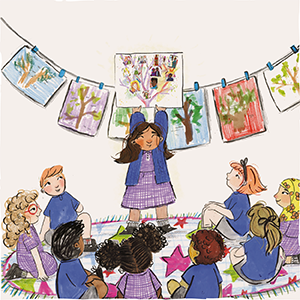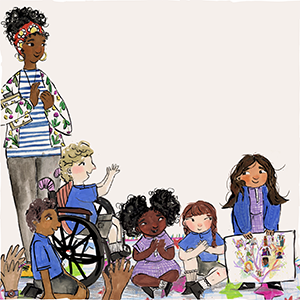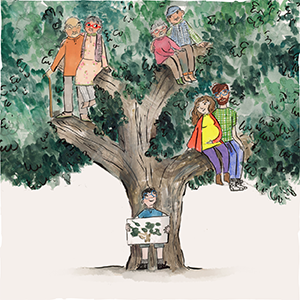Me, in the Middle
For ages 4+
When teacher, Miss Clark, asks the children to hop onto the country that their parents come from, Georgie feels confused…
By Annette Demetriou, illustrated by Angela Mayers (Owlet Press, 2022)
With the surge in interest in heritage and ancestry over the last decade, what a fitting book for children to explore what a family tree means for them. These days, asking the question ‘so where are you from?’ based on physical appearance is a complex issue, and quite rightly so. Decades ago we didn’t live in such a beautifully rich and diverse multi-cultural society, especially outside of the major cities. Children these days have a very different visual societal experience and questioning where a classmate is from based on the colour of their skin or hair type just isn’t going to follow the same logical reasoning as of their grandparents or even parents. This being said, the boom in information and social media awareness has resulted in a necessity for our children to be equipped with knowledge and understanding about their identity and their culture, as much for their protection as for their power.
I very much enjoy and love learning about culture and history. I have a degree in history, and finding out about the past fills me with interest and intrigue. Having researched our family history for our children, they were fascinated to find out they are essentially British/Norwegian/Ukranian/Russian! Whilst we don’t want to live in the past, we certainly need to learn about it in order to inform and interpret our present and our future. This is a super story, beautifully illustrated and published by the wonderful inclusive children’s publisher Owlet Press, that strengthens the awareness we all need about our roots, whilst having compassion and understanding of differences with others.
About the Story
Georgie’s class are playing a fun game! Teacher, Miss Clark has drawn a chalk map of the world on the playground and the children have to stand on the country they live. In a mad dash, all the children try to squeeze onto England. However, when Miss Clark asks the children to hop onto the country that their parents come from, Georgie feels confused… which country should she stand on? Panicking and after some teasing from classmate, Ben, she then forces her way back to England and when there’s no more room, she heads over to stand on East Africa. Ben says “Why are YOU in Africa?” Miss Clark helpfully points out to all the children how diverse they all are evidence by children standing on Japan, India, Brazil… Miss Clark gets frustrated with Georgie's uncertainty too and asks her to go back to stand on England. Then if things couldn’t get any worse… there’s no room again and classmate Dan says “Go back to Africa”; then Effie says Georgie’s skin is too pale to be from Africa! Thank goodness the bell rings and it is time to go home.
Reading the first few pages of the book, you know your empathy or compassion is working when you feel that awful feeling in the pit of your stomach. It’s uncomfortable reading for a reason. This is a great point to stop reading and check in on how the child or children you are reading with are feeling.
Once at home, Georgie’s mum and dad help Georgie with her family tree project by sticking photos of her ancestors to a tree, instead of just names. Great idea! Georgie’s leaves on her tree are also cleverly painted on the left side for mum in the shape of Ireland and on the right side for dad in the shape of Africa. And guess what…. Georgie is in the middle looking so happy and proud. Her tree is so colourful and educational with the addition of the photos that the children in the class are able to understand skin tones and difference in hair colour and textures too. Absolutely worth the shiny gold star for excellent work from Miss Clark!
The children have learned a valuable and non-confrontational lesson about why you should never judge someone by their skin/hair/facial features. The children head out to the park to look at real trees and the reader then finds out more about the family trees of other children in Georgie’s class. For example her friend Seren who is adopted by a two mums, but themselves come from different heritage backgrounds.
There is a lovely double page spread illustration of the children in a tree waving flags representing the different countries of their heritage. Great for testing flag knowledge!
On the last page, there is a ‘Make your own family tree!’ page too. They’ve thought of everything!
I’d highly recommend this beautiful book for at home, in classrooms and in libraries… and I can’t wait use this in my school book clubs.




